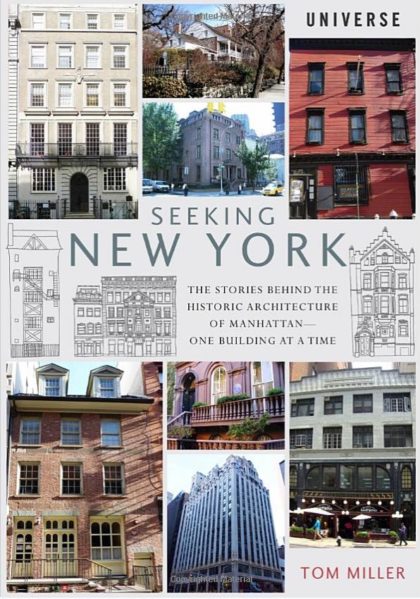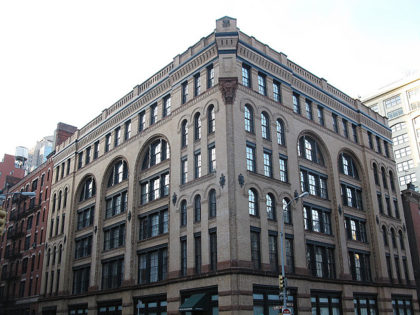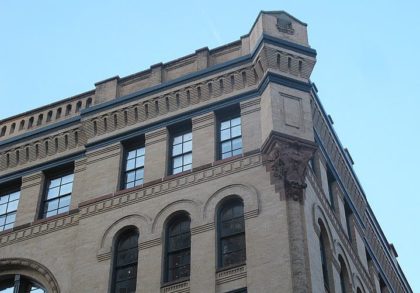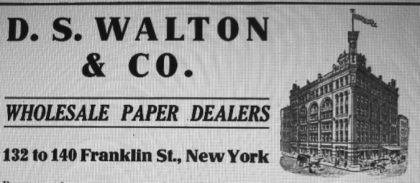The History of 140 Franklin
 Tom Miller, who writes about the history of Manhattan buildings at Daytonian in Manhattan, has allowed Tribeca Citizen to create a database of his Tribeca posts. If you enjoy these, and you will, then you should definitely check out his website, which also has write-ups about buildings all over the island. And don’t miss his book, Seeking New York: The Stories Behind the Historic Architecture of Manhattan—One Building at a Time.
Tom Miller, who writes about the history of Manhattan buildings at Daytonian in Manhattan, has allowed Tribeca Citizen to create a database of his Tribeca posts. If you enjoy these, and you will, then you should definitely check out his website, which also has write-ups about buildings all over the island. And don’t miss his book, Seeking New York: The Stories Behind the Historic Architecture of Manhattan—One Building at a Time.
··································
 The neighborhood of Franklin and Varick Streets had become decidedly industrial by 1886, when the National Folding Box and Paper Company decided to build its new headquarters building there. David S. Walton, Jr., was running the company that his father founded when he commissioned Albert Wagner to design an up-to-date, Romanesque Revival building similar to the first section of the Puck Building the architect had just completed.
The neighborhood of Franklin and Varick Streets had become decidedly industrial by 1886, when the National Folding Box and Paper Company decided to build its new headquarters building there. David S. Walton, Jr., was running the company that his father founded when he commissioned Albert Wagner to design an up-to-date, Romanesque Revival building similar to the first section of the Puck Building the architect had just completed.
Walton’s company manufactured folding boxes—a wildly popular space saving innovation—and wrapping paper. “Wrapping paper” in the 19th century had nothing to do with gaily printed birthday and holiday papers; but was the sturdy brown stuff that protected parcels.
Wagner produced a goliath industrial building of tan brick with cast iron and terra cotta touches. Huge centered arches flanked by groupings of smaller two-story arches broke the heavy mass of the masonry structure. At the corner, a tall clock tower rose several stories, flanked by decorative parapets.
 Above the southwest corner, a tall clock tower originally stood.
Above the southwest corner, a tall clock tower originally stood.
··································
The industrious Walton was not only President and Director of the National Folding Box and Paper Co.; he was also President and Director of the Virginia Manufacturing Co.; Treasurer and Director of the Merchants Safe Deposit Co.; Director of the Colonial Assurance Co., Essex County Trust Co., Merchants Trust Co., and Union Bag & Paper Co. of New Jersey.
The new building, which stretched from No. 132 to 140 Franklin Street, housed not only the factory and office space of Walton’s company, but brought in rental income as well. In 1891, J. S. Fry & Sons was here when the firm ran an unusual ad in St. Nicholas Magazine: “WANTED—A RECEIPT. Desire a receipt for making chocolate cake and offer to pay for the best and simplest formula. Send postal card for particulars as to requirements.” (We have to remember that sometime in the mid-20th century cooking “receipts” became known as “recipes.”) Another tenant, Weiler Brothers, importers and wholesale grocers, was here at the turn of the century.
By 1911 Walton had established a subsidiary company, D. S. Walton & Co. That year the firm introduced a ground-breaking and life-changing idea for households: the garbage bag. Good Housekeeping Magazine extolled the new product. “These are bags made of heavy manila paper reinforced at the bottom by folds of the paper itself. They are designed to be placed in an ordinary garbage receptacle and hold garbage which is properly drained, but by no means necessarily dry. They do not leak, nor soften and burst with ordinary use and provide a sanitary and conveniently clean method of handling garbage.”
 In 1917 when D. S. Walton was producing paper garbage bags, the building still had its square corner tower and parapet (Paper magazine advertisement, February 14, 1917).
In 1917 when D. S. Walton was producing paper garbage bags, the building still had its square corner tower and parapet (Paper magazine advertisement, February 14, 1917).
··································
While World War I raged in Europe, the company thrived at home. In 1917, it announced that it had increased its capital “from $1 million to $2 million for expansion.” Four years later the company changed its name, dropping the word “paper” and becoming the National Folding Box Co.
The energetic head of the firm died in his home in New Haven, Connecticut on March 18, 1938, of bronchitis.
Argo International took over the mammoth building in the second half of the century. Founded in 1952, the company made parts for electric pumps. It owned and occupied the entire building for nearly fifty years.
But Manhattan is an island of flux, and neighborhoods constantly change. By the 1990s, the Tribeca area had filled with trendy restaurants and clubs, and industrial spaces were becoming high-end residences. In 1998, No. 140 Franklin was purchased and a $10 million renovation begun, turning factory space into 14 luxury condominiums.
Sanba Inc. was commissioned to design the residences aimed at hip owners with lots of cash. Architect John Furth Peachy’s designs resulted in jaw-dropping apartments—one having 27 windows and encompassing 6,226 square feet.
As Sanba’s president, Aldo Andreoli, promised, the exterior of Albert Wagner’s structure was unaltered. The imposing paper box factory still commands attention at the corner of Franklin and Varick Streets. And one homeowner has a lot of windows to wash.
··································
Photo credits from top: Alice Lum; Paper magazine.













